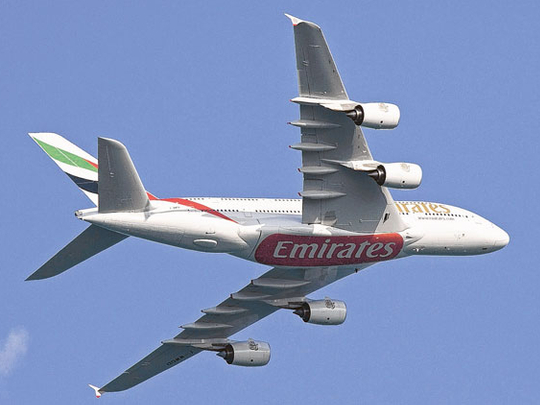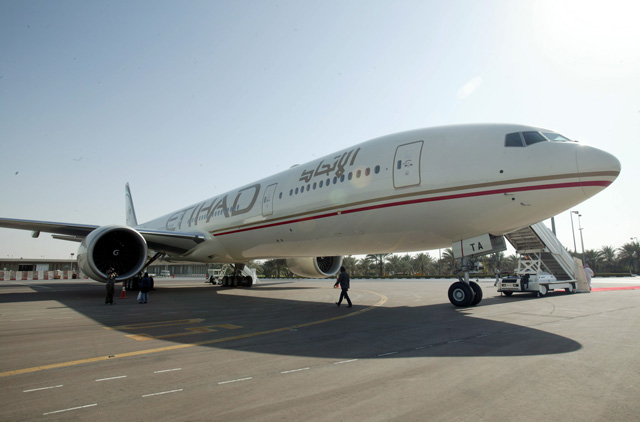
There is a saying by Wilbur Wright — one of the two Wright brothers — that goes: "It is not really necessary to look too far into the future; we see enough already to be certain it will be magnificent. Only let us hurry and open the roads…"
It seems the two big UAE airlines — Emirates and Etihad Airways — are following this mantra as they continue to raid global skies … and couldn't be more confident about the future.
Both carriers have aggressively expanded their respective networks and fleets in recent years despite challenging market forces trying to stall their growth, just like it's happening to all airlines globally. Turbulence in the industry came in the form of spiralling fuel prices, the Japanese tsunami and earthquake, volcanic eruptions, geo-political tensions in the Middle East and the global economic slump (including the Eurozone debt crisis).
Even though all these situations took some revenue out of these carriers' pockets last year, they didn't compromise on new route launches, additional frequencies and fleet expansion plans. It was business as usual.
On the contrary, a tighter economic environment forced some global airlines to either cut back routes or reduce frequencies in order to make up for the lost revenue. The latest casualty of the poor market conditions was Spanish carrier Spanair, which went bankrupt and ceased operations on January 27.
Both Emirates and Etihad, meanwhile, added five new destinations each last year — Emirates to Basra (Iraq), Geneva (Switzerland), Copenhagen (Denmark), St Petersburg (Russia) and Baghdad; and Etihad to Bengaluru (India), Male (Maldives), the Seychelles, Duesseldorf (Germany) and Chengdu (China).
The year also saw Emirates expanding capacity on many routes by adding frequencies and upgrading aircraft to accommodate growing passenger demand, according to Adnan Kazim, divisional senior vice-president for Planning and Research.
He listed some of the routes that benefited from additional frequencies. They include a third daily flight to Manchester, Sydney and Frankfurt; a second daily flight to Cape Town and Hamburg; six additional frequencies to Vienna; five additional weekly terminators to Singapore and Hong Kong; four additional flights per week to the Seychelles; and two additional flights per week to Narita.
"In 2012 Emirates will continue to rapidly expand its services across the worldwide network," Kazim told Gulf News, adding that eight "exciting new destinations" have already been announced, with more to be released in the near future.
Similarly, Etihad will also commence services on two new routes this year — to Shanghai from March 1, followed by Nairobi on April 1.
Acquisitions
The Abu Dhabi-based airline, however, expanded its route network to 269 through its acquisition of a 29.1 per cent stake in the loss-making German carrier Air Berlin in December.
Pursuing its strategy to grow through acquisitions, Etihad acquired a 40 per cent stake worth $20 million (Dh73.45 million) in Air Seychelles last month.
"We will continue our highly successful strategy of working closely with other carriers to maximise opportunities," said James Hogan, Etihad Airways president and chief executive.
"Etihad Airways has 35 code share agreements in place, allowing us to offer services, direct or indirect, to 269 destinations — 80 destinations more than any other Gulf carrier offers."
The airline signed seven new code shares last year including those with Air Astana, Air New Zealand, SNCF (French Railways), Czech Airlines, Vietnam Airlines, TAP Portugal and Hainan Airlines.
Hogan added that the airline has had a very successful 2011, "building depth and scale into our operation, adding new destinations, introducing product enhancements and cementing strategic new airline partnerships".
"And we will maintain the momentum this year as we take delivery of new aircraft and expand our network to destinations such as Shanghai and Nairobi, our first East African destination," he said.
So while Emirates has continued to grow organically through the years, Etihad's preferred growth path clearly seems to be through strategic acquisitions and alliances — the two models that seem to have worked well for both carriers, respectively.
As Toby Stokes, aviation sector leader for Europe, Middle East, India and Africa at Ernst & Young, pointed out: "One of the short-term strategies carriers employ to increase services is through alliances and other forms of airline cooperation such as code share agreements."
Stokes told Gulf News: "It is likely that GCC carriers will continue to outperform the global industry for the foreseeable future as they continue their expansion strategy which has been successful to date."
Global network
He added that the large Middle East airlines' corporate strategies are based on having a truly global network and they need to continue to expand in order to achieve this objective.
As Etihad stated, it is gearing for two new launches, to Shanghai and Nairobi this year, and Emirates has a full line-up ready for the year.
The Dubai carrier has already announced eight destination launches this year, with more to be released in the near future. Launch of flights to the South American cities Rio de Janeiro and Buenos Aires on January 3, followed by Dublin on January 9, marked the beginning of the year for Emirates.
The line-up for the rest of the year includes Lusaka and Harare route launch on February 1, followed by Dallas on February 2; Seattle on March 1; Ho Chi Minh City on June 4; and to Barcelona on July 3, opening the airline's second gateway in Spain.
Additionally, Emirates will also double frequencies to Madrid from July 1. The route was launched in August 2010.
This is not all. Emirates also recently announced additional frequencies to Glasgow, increasing the current daily service to a double-daily service from June 1, according to Kazim.
"Paris will also benefit from five additional flights per week in 2012. Effective March 25, the current double-daily Charles de Gaulle service will be supplemented by an additional four frequencies, increasing to five extra weekly flights in the winter 2012 schedule," he told Gulf News.
Etihad, too, is upbeat about its growth as it expects to become profitable this year. "The financial strategies that we put in place as long ago as 2006 are maturing and delivering results, and we expect to deliver sustainable profitability in 2012, after reaching break-even in 2011," says Hogan. "At Etihad Airways we are excited about 2012, concerns about the global economy notwithstanding."
Fleet expansion
In terms of the wider industry, however, Hogan said that 2012 will be a "very interesting year" as Gulf carriers continue to assert themselves globally in difficult financial conditions, particularly in the West.
He was quick to add: "Although the brunt of austerity is expected to be felt in the Eurozone and North America, with developing economies expected to fare considerably better, airlines in the Middle East are certainly not immune to the effects of slowed growth in the West."
Furthermore, oil prices, which were a wild card in 2011, are expected to remain so this year, according to Hogan. "Oil prices in 2012 are expected to remain volatile. We will continue our policy of hedging, providing a buffer of certainty against price spikes," he said.
This year will be one of Emirates' most important years in its 26-year history, says Kazim.
"The fleet will continue to grow at a rapid pace, averaging close to three new deliveries per month, including a mix of A380s and Boeing 777s," he said. The airline has been receiving an average one aircraft per month.
Emirates said it received 18 new aircraft in the 2011 calendar year, including 16 passenger aircraft (five A380s, 11 B777-300ERs) and two freighters.
Etihad Airways, meanwhile, took delivery of seven aircraft last year including three Airbus A330-300s, two Boeing B777-300ERs, one A320-200 and a B777-200F, the carrier said in a statement.
Clearly, the sky is the limit for these two carriers.
New trend: underserved offbeatroutes prove lucrative
A notable trend in the past year, along with expanding reach to key global cities, was airlines also increasingly bringing some uncommon and offbeat routes under their wings.
A case in point is Emirates' recent launch to Zambia (Lusaka), Zimbabwe (Harare), and Iraq (Basra). Asked about the economic viability of these unconventional routes, Adnan Kazim, divisional senior vice-president of Planning and Research at Emirates, told Gulf News: "Experience shows that the Emirates network, with over 100 destinations across the world, is a key catalyst in making such routes an immediate success, driven by a surge in business, tourism and VFR (visiting friends and families) traffic."
He added that Emirates strives to identify new market opportunities. "In addition to traditional routes serviced by many other international carriers we look to underserved, developing markets that have strong potential for growth in the future," Kazim said. "We do not add new destinations to our network without clear indications of market viability and passenger benefit."
Etihad Airways, meanwhile, did not respond to queries by Gulf News on the economic viability of unconventional routes.
Offering an independent perspective, Toby Stokes, EMEIA aviation sector leader at E&Y, says that expansion into newer routes, including those in emerging markets that are considered less conventional, is "key to achieving the network scale" and connectivity to realise their long-term ambitions of being among the top truly global carriers.
"In some cases, expansion has included emerging destinations which have historically not been adequately served by global carriers due to their own constraints," he said.
With regard to the economic viability of these routes, Stokes said that emerging markets such as the Bric countries (Brazil, Russia, India and China) as well as Africa, have huge populations and rapidly growing economies. "Therefore, they will need more and more connectivity to the rest of the world."
And expanding to these destinations achieves two objectives for airlines, he says: "Firstly, it makes the new destination less attractive for global competition that may also be planning to enter the same markets. Secondly, it can reduce the incentive for local and other carriers based there to expand internationally."
2012: New destinations
EMIRATES
- Rio de Janeiro (Brazil) Jan 3 Buenos Aires (Argentina) Jan 3
- Dublin (Ireland) Jan 9
- Lusaka (Zambia) Feb 1
- Harare (Zimbabwe) Feb 1
- Dallas (USA) Feb 2
- Seattle (USA) March 1
- Ho Chi Minh City (Vietnam) June 4
- Barcelona (Spain) July 3
Etihad
- Shanghai (China) March 1
- Nairobi (Kenya) April 1
2011: New destinations launched
EMIRATES
- Basra (Iraq)
- Geneva (Switzerland)
- Copenhagen (Denmark)
- St Petersburg (Russia)
- Baghdad (Iraq)
ETIHAD
- Bengaluru (India)
- Male (Maldives)
- Seychelles
- Duesseldorf (Germany)
- Chengdu (China)













